The deployment and maintenance of fiber infrastructure entail significant financial investments. Effective cost management plays a role in any ISP business to ensure viability and profitability. Those operating with fiber networks, understand the intricacies and infrastructure costs that go along with deploying fiber and the activity behind it.
Despite the undeniable benefits of fiber networks, ISPs encounter various challenges in managing costs. These challenges include navigating the complexities of infrastructure development, optimizing equipment expenditures, and balancing operational expenses such as personnel and maintenance costs.
Discovering financial strategies to address evolving market trends and technological advancements is a start in the right direction. As such, ISPs can implement cost management practices to mitigate risks, maximize efficiency, and drive sustainable growth to keep up with competitors.
In this blog, we will walk through actionable strategies and financial tools designed to help fiber ISPs in their journey towards long-term financial success!
Unique Cost Considerations in Fiber Network Operations
Infrastructure Development and Maintenance Costs
The installation and upkeep of fiber optic cables, alongside network infrastructure, demand significant capital investment and ongoing expenditure. From trenching and laying cables to maintaining fiber distribution hubs and data centers, every aspect of infrastructure development requires meticulous planning and budgeting to ensure the uninterrupted flow of services.
Equipment and Technology Investments
Equipment and technology investments represent another piece of cost management in fiber networks. Fiber ISPs rely on technology and equipment to deliver high-speed internet connectivity to consumers. This entails investments in routers, switches, fiber-optic splicing equipment, and other specialized hardware. Budgeting for equipment acquisitions and upgrades is vital to keep pace with technological advancements and maintain a competitive edge in the market.
Personnel and Labor Expenses
Skilled technicians, network engineers, and customer support staff are indispensable for the installation, maintenance, and troubleshooting of fiber networks. Budgeting for labor costs involves not only allocating funds for salaries and wages but also accounting for training, benefits, and other associated expenses.
Effective Cost Tracking Methods
Utilize Accounting or Financial Management Platforms
Utilizing accounting software and financial management platforms streamlines the tracking process, providing real-time insights into expenditure patterns and budget performance. These tools offer comprehensive features for recording expenses, tracking invoices, and generating financial reports, providing real-time insights into the financial health of the organization.
Implement Cost-Coding Systems
Implementing cost-coding systems facilitates easy categorization of expenses, enabling fiber ISPs to allocate costs to specific projects, departments, or cost centers accurately. By assigning unique codes to different expense categories, such as infrastructure development, equipment purchases, or personnel costs, ISPs can streamline cost tracking processes and gain a deeper understanding of where their financial resources are being allocated.
Establish Clear Documentation and Reporting Procedures
By documenting all financial transactions and maintaining organized records, fiber ISPs can easily track expenses, identify cost-saving opportunities, and analyze spending patterns over time. Clear reporting procedures enable stakeholders to access relevant financial information efficiently, facilitating informed decision-making and strategic planning.
Financial Planning Strategies
Setting Realistic Financial Goals and Objectives
Establishing clear and achievable targets that align with fiber ISP business objectives and market dynamics will be helpful in analyzing historical finances as well as forecasting. Whether aiming for revenue growth, market expansion, or cost containment, setting specific and measurable goals provides direction and focus for financial planning efforts.
Creating Financial Forecasts and Projections
Forecasts and projections enable fiber ISPs to anticipate future financial trends and challenges. By analyzing historical data and market conditions, ISPs can develop accurate forecasts of revenue streams, expenses, and cash flow, helping them to identify potential risks and opportunities.
Developing Strategies for Revenue Generation and Cost Reduction
Fiber ISPs can explore various avenues for revenue diversification, such as offering value-added services or targeting new customer segments. Simultaneously, implementing cost reduction measures, such as optimizing network efficiency, helps to minimize expenses and improve profitability margins. By adopting a proactive approach to financial planning, fiber ISPs can mitigate financial uncertainties to achieve sustainable financial health.
Utilizing Interactive Smart Reporting for Competitive Advantage
Access to real-time data and customizable reporting options allows ISPs to gain actionable insights into their financial performance, enabling them to make informed decisions quickly and effectively.
With Sonar’s financial tools, ISPs can harness the power of interactive smart reporting to access real-time data and customize reports according to their specific needs. Sonar’s reporting capabilities to gain visibility into key financial metrics such as account churn, activations, billing parameters, call logs, and more. This level of granularity empowers ISPs to identify areas for improvement, optimize processes, and drive profitability within their fiber network operations. Read more about these tools here: https://sonar.software/isp-billing-finance-reporting/
Managing Financial Aspects Efficiently with Sonar’s Tools
Sonar’s financial tools offer a comprehensive suite of capabilities designed to streamline financial management processes. Sonar’s flexible billing engine empowers growing telecom providers with automated billing and invoicing. Experience capabilities such as:
- Multi-month billing
- Usage billing
- VOIP billing
- Automatic proration
- Geographical taxation
- Touchless Invoicing
- Automatic late fees and more!
To learn more about how Sonar’s financial tools can revolutionize your cost management practices, click here: https://sonar.software/isp-billing-finance-reporting/

.
7 Ways Internet Service Providers Can Combat Inflation

Finding ways to increase efficiency and reduce operating costs will help alleviate some inflationary pressures. In this blog post, we have assembled some ways that Internet Service Providers can combat inflation and implement measures that will help minimize risk.




